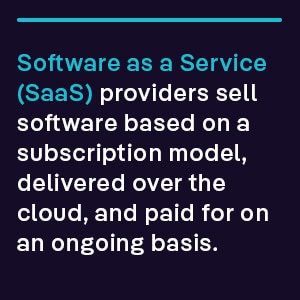Forward-thinking businesses have always relied on the latest digital technology to thrive. But the way that they deploy technology today is not the same as it used to be. These days, for instance, most companies are not buying shrink-wrapped software at a local store—instead, they are subscribing to software on the cloud.
Today, an average of 130 SaaS applications are used by just about every organization. By the end of 2023, Gartner predicted that organizations worldwide would have spent $195.2 billion on Software as a Service (SaaS) applications alone. But to ensure both sides of those relationships live up to their promises, the right contract terms are required—and, let’s face it, license agreements designed for traditional software (and associated professional services) simply just don’t work.
So, as the technology that organizations use changes year after year, so must the agreements that they rely on to manage that use. That is where SaaS agreements (also called Cloud agreements) come in.
What’s a SaaS Agreement Contract?

Whereas licensing agreements authorize customers to license a copy or copies (depending on the number of users) of a software copyright, allowing them to load the software onto their own computer(s), a SaaS agreement does not need to do that. Simply stated, as the SaaS product is accessed through the cloud exclusively, customers do not require various copyright licenses.
SaaS agreements are designed to outline the terms of use between a SaaS provider and the businesses or individuals they service. While not all SaaS contracts are the same, they must cover similar areas, from data ownership and cybersecurity to legal liability and license scope. SaaS agreements will also include the level of service that can be expected (the Service Level Agreement, or SLA), as well as payment terms, terms of service, and so on.
These cloud service agreements are critical in establishing a level of trust between SaaS providers and their customers. With these, both parties can feel confident that each side will continue to adhere to the conditions of the partnership for the duration of the contract.
Importance of a SaaS Agreement Contract
Many SaaS applications have a range of service levels sold at different price points. Those tiers may come with unique functionality offerings or user 
For SaaS Providers
SaaS providers will have their own expectations and concerns. They want to ensure that client will continue ongoing payments as agreed upon, will not use the software for illegal purposes, and will not exceed their user limit. Providers will also want to limit their liability in the case of a data breach or security issue and protect their software from the threat of abuse or hacking. SaaS agreements offer protection and assurances on both sides, ensuring that all expectations continue to be met.
For Clients
Clients will expect a certain level of service, performance, user access, and security depending on the subscribed-to SaaS application level. No matter which tier they subscribe to, they will also want to protect any private or personal data and ensure that support is timely when an issue impedes their work. So, they will look for terms and conditions that meet those needs.
Components of a SaaS Contract

- Access Rights and Users—details the number of users allowed under the terms of the contract, the conditions of use, and defines what a user is and the penalties for exceeding user restrictions
- Customer Support—states the level of support customers can expect, how that support will be provided, guarantees around service response time, and any other guarantees around and conditions for support
- Data Ownership—clarifies who owns data that is uploaded or entered into the SaaS application
- Data Security and Usage—outlines the encryption, backup, and security responsibilities of both parties, how often data will be backed up, and details what will happen to customer data in case of a security breach, company bankruptcy, or a termination of service use
- Liability—outlines the liability and risk between the SaaS provider and the customer, as well as the cap to contractual liability, and usually includes indemnification provisions as well (where one party assumes the risk and defense of the other party)
- Warranties—highlight the performance objectives and performance levels the SaaS provider guarantees, including the method of service delivery, uptime, and results
- Payment Terms—outline all details regarding the subscription plan, payment schedule, and payment amount (as they are usually based on a subscription model, the payment may be made monthly, quarterly, or yearly, depending on what the SaaS provider has negotiated with the potential client)
- SLA (Service Level Agreement)—usually an appendix that lays out performance standards and the service availability that can be expected, including uptime percentage, in more detail than the Customer Support and Warranty sections may include
- Termination, Cancellation, and Renewal—outlines the processes that need to be followed should the client want to terminate or renew their SaaS contract. (Most SaaS agreements will renew automatically from term to term, so if a customer chooses to terminate, they must do so before a specified date)
Types of SaaS Agreements

- Terms of Use for SaaS—lists the rights of users, terms of service, prohibited uses, conditions of user removal, warranties, and indemnification
- Framework Agreement for Software Development—if there’s going to be new development of software, including SaaS, this document offers a legal framework for the development of software by one company or individual on behalf of another (the copyright, or copyrights, are assigned and a statement of work provided)
- Assignment of Intellectual Property—or IP Transfer Agreements—assigns intellectual property ownership to the SaaS provider, ensuring that employees or contractors do not have rights to it
- Non-Disclosure Agreement (NDA)—is made between the SaaS provider and a secondary party—for instance, an employee or contractor—to ensure that confidential information can be shared freely between the two signing parties but not to anyone beyond
- Employment Agreement—outlines terms of employment and should be in place for all SaaS employees (it includes employee duties, rights, promises, employers’ rights, intellectual property assignment, and any documentation around stock options)
- Shareholders’ Agreement—explains the duties and rights of company shareholders, from founders to investors, including voting rights and company management and control provisions (it also outlines dispute resolution measures in the case of shareholder disagreements and explains how shares can be sold or exchanged)
- Service Level Agreement (SLA)—which can also be a standalone document, as mentioned above—outlines minimum performance expectations, availability, and software uptime (it should also include expectations for response times in the case of service issues and put penalties in place in case those guarantees are not met)
- Affiliate or Partner Agreements—are made between a SaaS provider and a secondary party outside of their direct control—namely, partners or affiliates (they outline the terms of the partnership, any promises or guarantees being made, and compensation expectations)
- Privacy and Security Policies—are particularly important in a SaaS environment, where proprietary or personal data is often employed (a privacy policy outlines procedures for gathering, using, disclosing, and managing user data; a security policy highlights the SaaS provider’s data security measures, including processes and conditions around encryption, backup, disaster recovery, and data compliance)
End-to-End SaaS Agreements with ContractPodAi
ContractPodAi’s One Legal Platform automates contract management for SaaS providers. Draw on best-in-class capabilities and proven best practices to assemble SaaS agreements based on your own terms in order to mitigate risk and expedite sales. All while accelerating your contract lifecycle and giving you complete visibility into and control over your legal documents. Talk to one of our legal experts and book a demo today to find out more.








